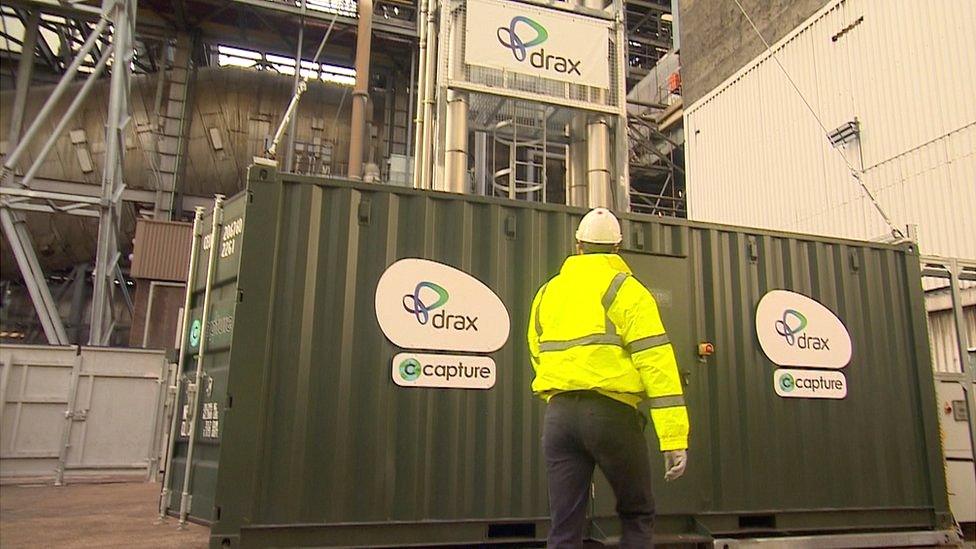Energy makes its move
- Published

Oil companies are switching on to renewable technology, to reduce their carbon footprints and be ready for a more electric future.
Hopes for a carbon capture and storage industry in Britain have been revived. A new report suggests it could sustain 44,000 jobs in Scotland.
North Sea collaboration is being encouraged between offshore wind and offshore oil, with far-reaching possibilities for generating power from gas out at sea, and creating a new hydrogen industry.
Oil majors have long been trying to mix some greenery with the black stuff, but it's clear now that the pace of that transition is picking up.
There was an audible jolt in the industry when Norway's vast pension fund - built up from tax revenue and profits from offshore drilling - announced it is pulling out of investment in oil company equities.

Norway's huge pension fund is pulling out of oil company equities
The Global Pension Fund is seen worldwide as a leader in shaping investment with ethical, environmental and social considerations.
Yet - understandably, for a country that still has a lot more oil and gas to extract - the Norwegian investors said they were not joining the "leave it in the ground" movement, but instead that they did not want to be over-exposed to oil price volatility.
This came a few months after Statoil - the largely state-owned driller in Norwegian waters and many other basins besides - rebranded with the less statist and polluting moniker of Equinor.
It is reported on Tuesday, by Fortune news website, that the company is pouring $180m into a battery research programme.
It is also one of the major investors in UK windfarms, from the humongous Dogger Bank project to the world-leading Hywind floating turbines off the coast at Peterhead.
Plodding carbon footprints
Shell is making very clear moves towards a more electric future. Having bought First Utility last year - one of the larger challengers to the Big Six supplying British households and businesses - on Tuesday, it announced a rebrand to Shell Energy.
Renewable power will be standard for its customers and (with a somewhat mixed message), it's offering discounts at its forecourts, along with signs that it wants to take on other utilities with an interest in bundling telecoms as well.

Shell recently entered the household energy market by buying the supplier First Utility
Shell has also been buying up technology, including a German battery storage manufacturer and a British tech firm, Limejump, focused on improved flexibility in matching power demand with supply.
BP is investing in solar power. It's reported to be looking at a shift to renewable energy at its US operations. Extracting oil and gas from the ground can be very intensive in its use of hydrocarbons. So companies such as BP want to reduce their carbon footprints at the same time as producing the goods with which the rest of us can keep plodding on with ours.
It's reported in Texas that the company is ploughing $100m into ideas from its staff and supply chain that can reduce its carbon footprint. Chief executive Bob Dudley told a Houston audience earlier this month that the world's energy use is not on a sustainable path. Oil majors say the power sector has to take much of the blame, but they know they have to do more.
Billion pounds snaffled
Closer to home, there are moves afoot to get back into the technology for carbon capture, usage and storage (CCUS). This has been proven in pilots, and offers the possibility of letting us keep burning fossil fuels so long as the carbon emissions are treated and buried deep under the seabed.
The central North Sea, off the Scottish coast, is one of the more promising locations for developing the technology at a commercial scale - reckoned to have 75% of the capacity estimated so far.
You may recall that there was £1bn of UK government money being offered in a competition between different CCUS projects (it's added "usage" since then).
Scottish Power was in a strong position to put that to work at Longannet power station in Fife, but lost patience, and closed the coal-burner down. Peterhead was still burning gas, and was in the final two when, in November 2015, that billion quid was quietly snaffled by the Treasury and put into a more pressing political priority.
It hasn't killed off the dream. Four years on, Whitehall has just set up an advisory group of businesses, including BP, Shell, Drax and Tata Steel to advise on how best to get CCUS moving again. The group's budget: £1m. That is, a thousandth of what was available before.

Drax has begun a project capture one tonne per day of CO2 at a site in North Yorkshire
Meanwhile, there are still projects afoot at a Yorkshire biomass plant owned by Drax. And under new management, Crown Estate Scotland has put some Strathclyde University economists to work on the impact that could yet be derived from developing CCUS. The Crown Estate licences the seabed for such storage, and wants to plan ahead.
Its study was published on Tuesday, with some large numbers in terms of economic impact. The main thrust of a dessicated piece of economic writing is to shift the measure of CCUS from its environmental positives, set against its very high costs, and to account also for its economic impact.
Gunge
Thus, the Strathclyde Centre for Energy Policy observes that CCUS would allow the UK offshore oil and gas sector to keep pumping from its subsea wells, while offsetting its climate harm by pumping processed carbon gunge into the emptied rock formations.
If it does so, this study is talking about 26,000 directly linked jobs in the on-shore support industry and another 18,000 supply jobs downstream.
It's further reckoned that this could help process industries de-carbonise to support the "just transition" from carbon emissions which was pledged in the Paris Agreement.
So although CCUS has been one of the most expensive ways of cutting carbon emissions (using less energy in better insulated buildings is the cheapest way), it offers one of the highest returns per pound invested in terms of jobs created or sustained.
And like long-awaited buses, Tuesday also brought news from Wood group in Aberdeen, that it has been contracted to do the design concept stage of a "first-of-a-kind" gas power plant with CCUS built into its processes.
The programme will initially cover five principal industrial emitters of carbon dioxide, in the production of hydrogen, fertiliser, petrochemicals, cement, and steel.
Wood is another company that has moved sharply to avoid over-exposure to the volatility of the oil price, and particularly to the oil industry in the North Sea.
Gas by-catch
To underline the mood of an industry that is preparing for a change of gear and direction, the Oil and Gas Authority - also in Aberdeen, as regulator of the UK industry - recently set out its plans to link the business of hydrocarbon extraction with the business of replacing it. That is, it wants the oil and gas sector to work imaginatively with the offshore wind and marine power sector.
In addition to carbon capture and storage, the ideas it's floated include:
Drawing power direct from offshore wind turbines to replace the gas burning used on nearby offshore platforms.
Burning gas to generate power on offshore platforms, and using new, extensive subsea cabling to get that power to the onshore customers. That would obviously remove the cost of getting gas to the mainland, and would put Britain's new generation of power stations out at sea. They've come a long way from flaring all their gas by-catch
Over the time horizon, hydrogen cells are seen as the future of transport, but that requires a lot of power to separate the element from oxygen in water through the process of electrolysis. Offshore platforms could become the place to do that, using power from those nearby wind turbines.
Yet more developments: the OGA has just dumped a vast amount of seismic surveying data in the public domain ("equivalent to eight years of high definition films") which ought to help industry to identify the best places for carbon storage.
In short, it's a busy time for a big transition in the energy sector.